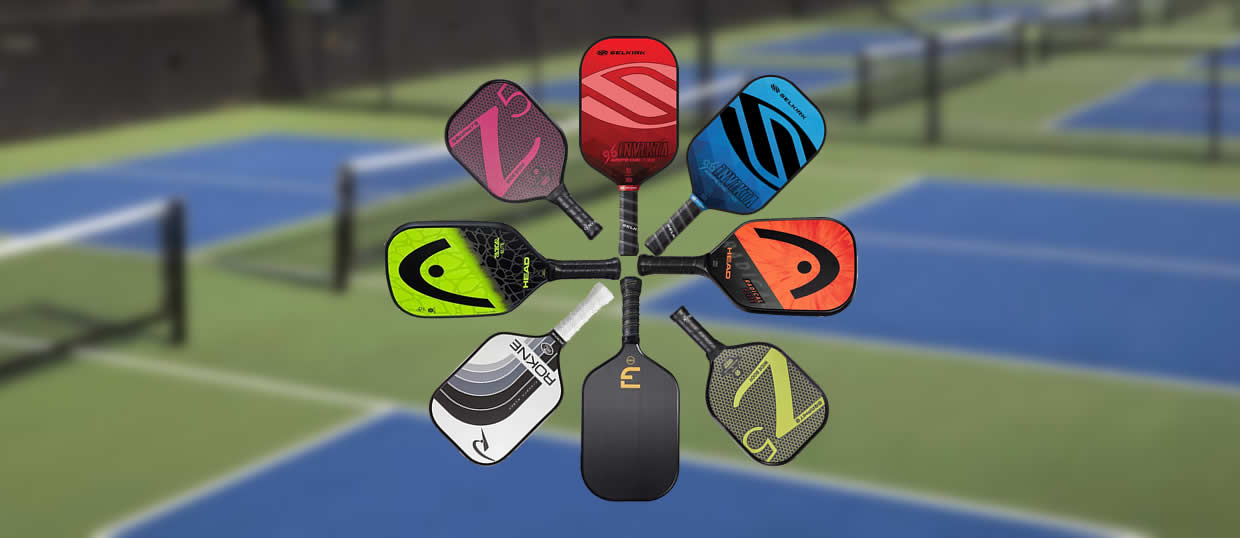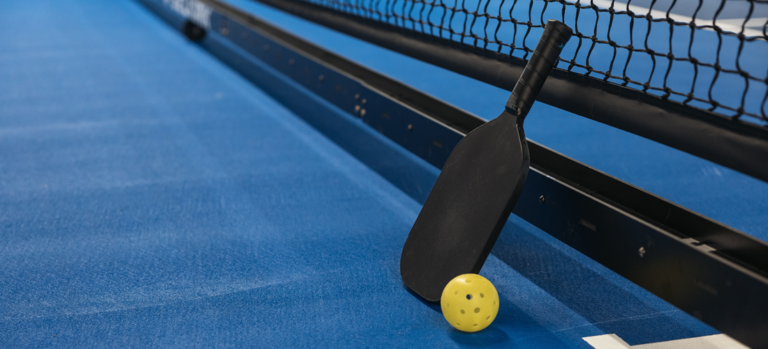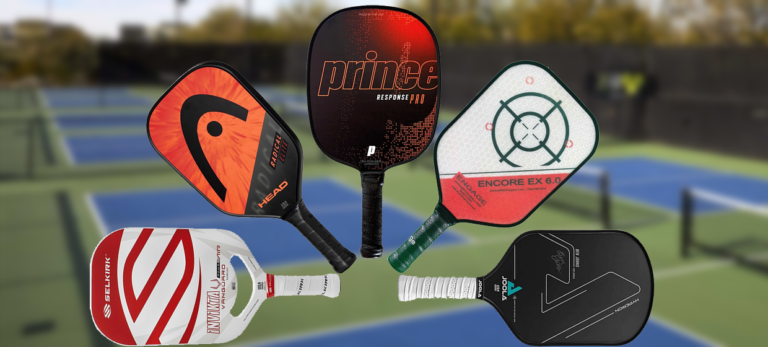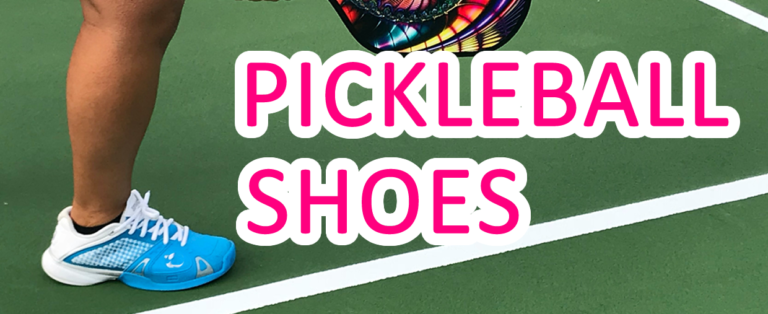Pickleball Paddles Guide
The right pickleball paddle can make or break your game, so it’s important to choose the one that best fits your style and skill level. There are many different types of pickleball paddles available, each offering its own unique advantages. From lightweight composite materials to heavier wooden options, there’s something for everyone when it comes to choosing a pickleball paddle!
What Makes For Legal Pickleball Paddles?
If all the pickleball games that you’ll ever going to play are recreational ones then you can use whatever pickleball paddle that you want. However, if you are playing tournaments it’s important that your paddles adhere to the USA Pickleball Equipment Standards. The following is a summary of standards the paddle must meet:
- must be made of rigid, non-compressible material
- surface must be smooth and non-reflective with no features that will impart excessive spin on the ball
- no restriction on shape, thickness, or weight
- paddle length and width must not exceed 24 inches with the paddle length not exceeding 17 inches (must include edge guard and cap at the end of the handle in the measurement)
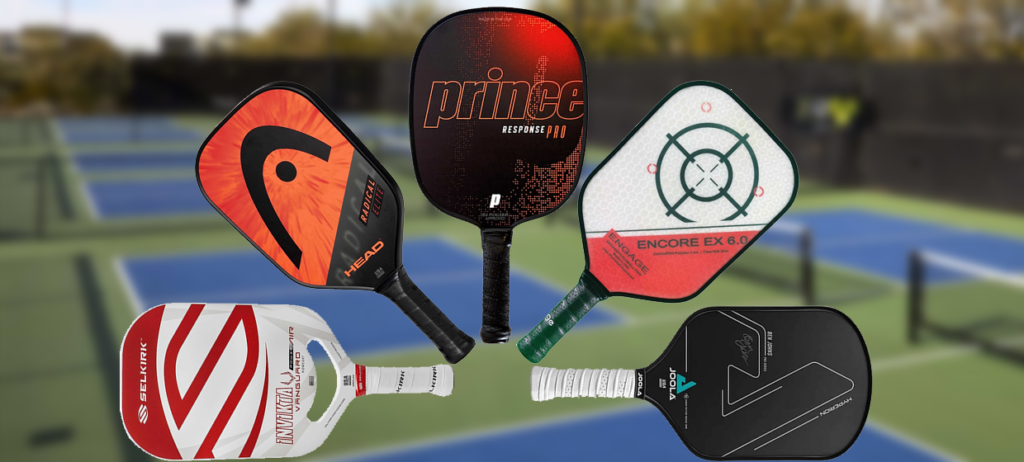
Check out our recommendation for the best pickleball paddles
What To Consider When Choosing Pickleball Paddles?
When selecting a pickleball paddle, there are several important characteristics to consider in order to ensure a positive experience. Grip, weight and balance, material and power vs control are all critical factors when evaluating which paddle is optimal for your game.
Grip Length and Size
Finding the right grip size is essential for a comfortable and secure hold. If the grip is too small, you won’t be able to control the paddle correctly; if it’s too big, you could experience hand fatigue over time. Consider trying out several paddles with different grips to find the one that fits your hands best.
The grip of a pickleball paddle is an essential element for comfort and performance. It is important to find a grip that fits your hand correctly and provides enough friction for added control. Additionally, the weight and balance of a paddle plays an important role in generating power. The lighter paddles will provide more speed when hitting while the heavier paddles with better balance will generate more stability and spin.
Weight
The weight of the pickleball paddle can greatly affect your performance on the court. A paddle that is too heavy can slow you down, while a lighter one may give you more speed and power. Try out paddles with different weights to find the one that feels best in your hands.
Head-heavy paddles have a higher swing weight. If you want more power, the heavier the head of the paddle is, the more energy will be translated into the ball at the cost of maneuverability.
Face Shape
Pickleball paddles come in different shapes, which all have an impact on your gameplay. A larger face provides more power and spin, while a smaller one gives you better control. Consider the type of shots that you want to be able to hit with your paddle when choosing the right face shape for your style.
Traditional
The traditional pickleball face shape is square with rounded edges. This type of paddle provides the most balance in terms of playability. It has a large hitting surface which means a larger sweet spot but at the same time has enough maneuverability switching between forehand and backhand.
Elongated
The elongated paddle provide extra reach either by shortening the handle length or reducing the paddle width. It is most often used in singles play where players need to cover more area on the sides. It is not as balanced as the traditional shaped paddles since you sacrifice maneuverability. The extra length makes it heavier to swing from forehand to backhand.
Round/Oval
The rounded edges on the round or oval paddles gives it the most maneuverability among all the paddle shapes. You do sacrifice on the extension and the odd shape can take a bit of getting used to when switching from a more traditional paddle shape.
Handle Length
The length of the paddle’s handle is also important, as it affects your reach and stroke. Longer handles require more power but provide better reach, while shorter ones are easier to control. A longer handle also makes it easier to have a two-handed grip on your paddle which more and more players are using for a two-handed backhand shot.
Again, consider trying out paddles with different lengths to determine which one best suits your needs.
Material
The material of the pickleball paddle is another factor to consider. When you’re talking about paddle materials, you have to differentiate between the core and the surface materials that make up the paddle. The core of the paddle is the panel that sits in the middle between the two surface panels on either side. It is usually built in a honeycomb pattern.
Before we get into the different materials for the core and surface panels, let’s first discuss wood paddles. The earliest pickleball paddles were made from wood. Unlike paddles constructed with different materials for the core and surface panels, wood paddles use wood for both panels. As such wood paddles lack the advantages paddles made form other materials have. Although they are the cheapest of the different paddle types, they also tend to be the heaviest so most players often move on to other types of paddles.
Core Materials
The most common type of core materials are:
- Aluminum – Paddles made with aluminum core gives a softer rebound to the ball. That and the lighter weight of aluminum gives players more maneuverability and control of their shots. A disadvantage of aluminum cores is the loss of power. Also, they tend to get dented over time so they are not recommended for hard hitters.
- Nomex – Nomex is a synthetic non-metallic material known for its lightness, high strength, and rigidity. Paddles made with Nomex cores are known for their consistency and durability and are preferred by players looking to add more power to their shots. You will lose a bit of control with Nomex cores.
- Polymer – Polymer cores have the most balance between power and control which makes them the most popular core for pickleball paddles. This type of core is the most flexible making the ball come off softer on impact. The flexibility makes the paddle the most quiet type and a recommended option for playing in communities with noise restrictions.
Surface Materials
Along with the core, the type of surface material gives a pickleball paddle its unique characteristic. The most common types of surface materials are:
- Graphite – Graphite paddles are lightweight, allowing for effortless swings with quick response times. The graphite composition of the paddle also provides more power and control over shots, allowing you to produce faster volleys and spin shots with greater accuracy.
- Carbon Fiber – Carbon fiber is the most durable and lightest of all the types of paddle surfaces making it the most expensive option as well. The soft surface material makes for excellent control but can lose a bit of power compared to other surfaces.
- Fiberglass Composite – Fiberglass composite pickleball paddles offer a variety of advantages that set them apart from other paddle materials. First and foremost, fiberglass is a very durable material, meaning it can stand up to lots of use and abuse. This makes fiberglass composite paddles an ideal choice for those who play frequently or who have a competitive mindset. Furthermore, fiberglass paddles are extremely lightweight which makes them easier to maneuver and control the ball with precision.
Price
Another thing to consider when choosing a pickleball paddle is the price. You can get a pickleball paddle for less than $20. If you are a casual player or new to the game a cheap, regular paddle might be enough for you. But if you play often or have advanced in the game, investing in a better pickleball paddle can do a lot for the quality of your game. Most people who play regularly have paddles in the mid-price range ($50 to $150) but for those willing to invest more in their game there are pickleball paddles above the $200 price range.
Tips for Selecting the Right Pickleball Paddle for Your Gameplay Style
When selecting the right pickleball paddle for your unique gameplay style, there are several factors to consider. It’s important to find a paddle that complements your playing style and gives you the best chance of winning.
You want to decide between power and control when selecting a paddle. Power is essential for sending the ball over the net with ease and speed. Control allows you to make accurate shots that reach their intended destination. A combination of both is ideal, but depending on your skill level and style of play, one may be more important than the other.
Power Player
When choosing a pickleball paddle, power players should consider several factors. Firstly, they should look at the weight of the paddle; power players generally prefer heavier paddles as they provide more control and power for shots. Heavier paddles also tend to help with accuracy, making them ideal for intense games.
Power players can also benefit from paddles with larger heads – these offer more power on shots. Additionally, a thicker core will provide extra power and reduce vibration when hitting the ball.
Finally, the grip should be comfortable for the player. Larger grips are often better suited for players who generate a lot of spin on their shots. For those seeking control, a thinner grip is usually the best option.
Control Player
Choosing the right pickleball paddle can be a challenge for players who are looking to up their game by gaining more control and accuracy in their shots. There are several factors to consider when selecting a paddle that will give you the right combination of power, control, spin, and feel.
First, look at the weight and size of the paddle. Lighter paddles are better for easy control and accuracy. The length of the shaft also plays a role in both power and reach. Shorter paddles offer more maneuverability but less reach, while longer paddles give you better leverage to put force behind your shots.
Next, consider the material and construction of the paddle. Paddles made from composite materials like graphite or aluminum are lighter and provide better control over your shots. The grip size is also important; smaller paddle grips are better for finesse shots.
Finally, decide if you want to customize your paddle with grip tape or dampeners to increase control and accuracy. Dampeners absorb some of the vibrations that come from contact with the ball, giving you a softer feel when hitting shots. Grip tape adds cushioning to the handle so it feels more comfortable in your hand and gives you better control over your shots.
A Final Word on Choosing the Right Pickleball Paddle for You
Choosing the right pickleball paddle doesn’t have to be a daunting task. Consider your grip, weight and balance, material, and power vs control when evaluating which option is best for you. With this guide as your reference, you’re sure to find the perfect paddle that meets all your gaming needs!
By considering all of these factors, you’ll be able to find the right pickleball paddle that will help bring your game to the next level. With a little research and practice, you can choose a paddle that will give you power, spin, accuracy, and comfort. With the right paddle in hand, you’ll be ready to take on any opponent! Good luck!
